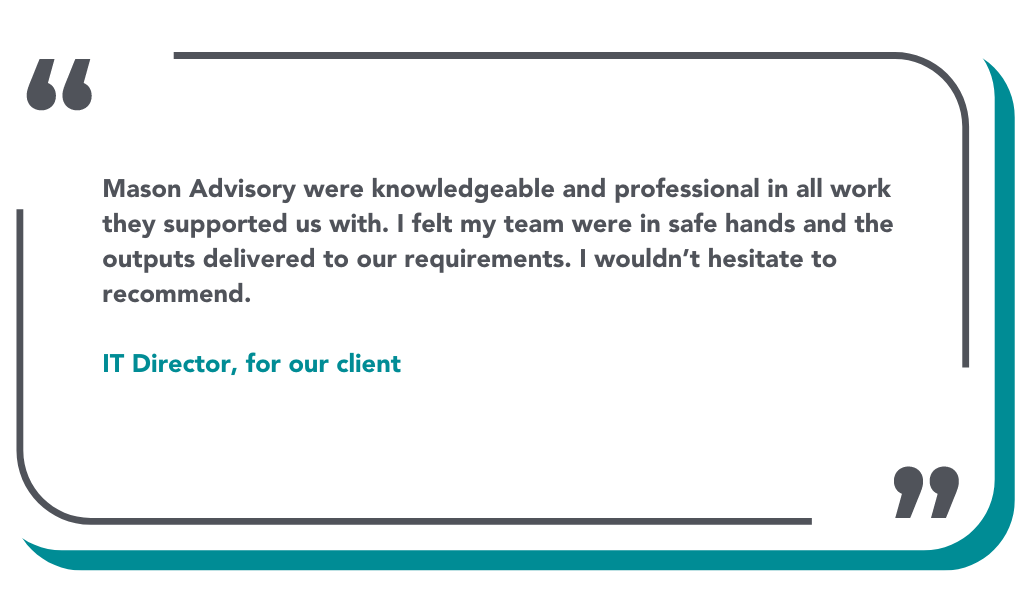Transforming cost-value modelling and pipeline management for a healthcare technology supplier
Share:

key fact
NHS England’s Transformation Directorate has set ambitions for the majority of health and social care services to have digital foundations in place by March 2025, making IT systems and services essential drivers of the NHS’s future.
The NHS Long Term Plan is dramatically impacting on procurement models in England’s health and social care sector. New initiatives, including the introduction of Commissioning Support Units (CSUs), the Health Care Act 2022 and the Health Care Services (Provider Selection Regime) Regulations 2023, encourage a shift from maintaining established regional supply chains to a more competitive model. Healthcare authorities have been given increasing flexibility in how they select providers to support the delivery of integrated care.
Health and social care providers are also looking to procure and embed new technology to support the NHS’s ambitions for digital transformation. For the organisations who provide these IT and technology solutions, this changing demand and procurement landscape means that previously established customer relationships are being disrupted. Continued growth depends on the ability to expand the commercial pipeline with full confidence that every contract can be efficiently and effectively fulfilled.
Challenge
Our client provides IT services and systems for healthcare providers in the UK. The organisation has a large portfolio of customers which is only becoming more complex. This is great news for the business but, at the time of our engagement, it was causing both the pace and complexities of pipeline management to increase. As a result, the IT Directorate was facing significant challenges in accurately tracking and apportioning costs. A more integrated approach was needed to link transparent sales pipelines with IT cost modelling and facilitate streamlined delivery of procured systems and services within budget.
To tackle the issue, our client’s Finance Directorate approached Mason Advisory to perform an independent assessment of the sales and delivery cost modelling approach. The Finance team needed to understand the current financial position of the IT Directorate in relation to costs and charges, with the aim of identifying a cost apportionment method to IT Directorate customers and ensuring appropriate cost recovery.
Solution
Mason Advisory worked closely with the Finance Director (who was also the project sponsor) and the IT Directorate for the duration of the engagement. We supported them to tackle the IT Directorate’s immediate challenges, plus wider challenges across the enterprise, including aligning cost apportionment and recovery relating to the CSU approach to obtaining customer contracts.
We conducted a detailed and thorough review of the current cost modelling approach and data, generating business-critical visibility across the existing cost apportionment pipeline. We also performed a wider programme of work including inception and discovery with key stakeholders, expert analysis of how costs and charges are currently modelled, apportioned and delivered, and identification of more than 40 actionable recommendations to improve the approach.
Using an internationally recognised framework, we delivered an improved cost-value model alongside an associated value target roadmap. To enable robust implementation of the new model, we recommended a clear governance approach to monitor and steer the implementation process.
To ensure complete transparency for our client, we continued to engage with key stakeholders via weekly review boards, regular sessions with the project sponsor, iterative review and approval cycles for documentation and outputs, and frequent one-to-one sessions for all stakeholders.
Outcome
Our client is now equipped with transformed visibility across the IT Directorate’s cost model and pipeline, which has identified risks, savings and benefits that were previously not fully articulated. The finance team and IT directorate are more aligned around cost governance approaches and practices. Leadership has received and approved more than 40 clear, pragmatic recommendations and next steps to improve financial visibility as well as general ways of working.
The new cost-value model and value target roadmap solve the challenges of cost pipeline visibility, while also providing a blueprint and maturity roadmap for monitoring, improving and aligning future products and services to the business strategy, the needs of health and social care customers and, in turn, end users of our client’s IT systems.
If you would like to speak to one of our industry experts regarding this case study, email contact@masonadvisory.com Find out more about our services.
